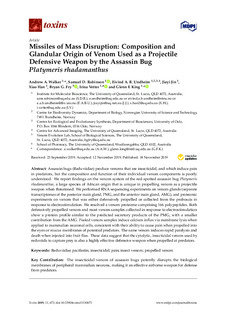| dc.contributor.author | Walker, Andrew A. | |
| dc.contributor.author | Robinson, Samuel D. | |
| dc.contributor.author | Undheim, Eivind Andreas Baste | |
| dc.contributor.author | Jin, Jiayi | |
| dc.contributor.author | Han, Xiao | |
| dc.contributor.author | Fry, Bryan G. | |
| dc.contributor.author | Vetter, Irina | |
| dc.contributor.author | King, Glenn F. | |
| dc.date.accessioned | 2020-02-17T17:13:17Z | |
| dc.date.available | 2020-02-17T17:13:17Z | |
| dc.date.created | 2020-01-14T08:33:22Z | |
| dc.date.issued | 2019 | |
| dc.identifier.citation | Toxins. 2019, 11 (11), 1-21. | nb_NO |
| dc.identifier.issn | 2072-6651 | |
| dc.identifier.uri | http://hdl.handle.net/11250/2642098 | |
| dc.description.abstract | Assassin bugs (Reduviidae) produce venoms that are insecticidal, and which induce pain in predators, but the composition and function of their individual venom components is poorly understood. We report findings on the venom system of the red-spotted assassin bug Platymeris rhadamanthus, a large species of African origin that is unique in propelling venom as a projectile weapon when threatened. We performed RNA sequencing experiments on venom glands (separate transcriptomes of the posterior main gland, PMG, and the anterior main gland, AMG), and proteomic experiments on venom that was either defensively propelled or collected from the proboscis in response to electrostimulation. We resolved a venom proteome comprising 166 polypeptides. Both defensively propelled venom and most venom samples collected in response to electrostimulation show a protein profile similar to the predicted secretory products of the PMG, with a smaller contribution from the AMG. Pooled venom samples induce calcium influx via membrane lysis when applied to mammalian neuronal cells, consistent with their ability to cause pain when propelled into the eyes or mucus membranes of potential predators. The same venom induces rapid paralysis and death when injected into fruit flies. These data suggest that the cytolytic, insecticidal venom used by reduviids to capture prey is also a highly effective defensive weapon when propelled at predators. | nb_NO |
| dc.language.iso | eng | nb_NO |
| dc.publisher | MDPI | nb_NO |
| dc.rights | Navngivelse 4.0 Internasjonal | * |
| dc.rights.uri | http://creativecommons.org/licenses/by/4.0/deed.no | * |
| dc.title | Missiles of mass disruption: Composition and glandular origin of venom used as a projectile defensive weapon by the assassin bug Platymeris rhadamanthus | nb_NO |
| dc.type | Journal article | nb_NO |
| dc.type | Peer reviewed | nb_NO |
| dc.description.version | publishedVersion | nb_NO |
| dc.source.pagenumber | 1-21 | nb_NO |
| dc.source.volume | 11 | nb_NO |
| dc.source.journal | Toxins | nb_NO |
| dc.source.issue | 11 | nb_NO |
| dc.identifier.doi | 10.3390/toxins11110673 | |
| dc.identifier.cristin | 1771952 | |
| dc.description.localcode | © 2019 by the authors. Licensee MDPI, Basel, Switzerland. This article is an open accessarticle distributed under the terms and conditions of the Creative Commons Attribution(CC BY) license (http://creativecommons.org/licenses/by/4.0/). | nb_NO |
| cristin.unitcode | 194,66,10,0 | |
| cristin.unitname | Institutt for biologi | |
| cristin.ispublished | true | |
| cristin.fulltext | original | |
| cristin.qualitycode | 1 | |

